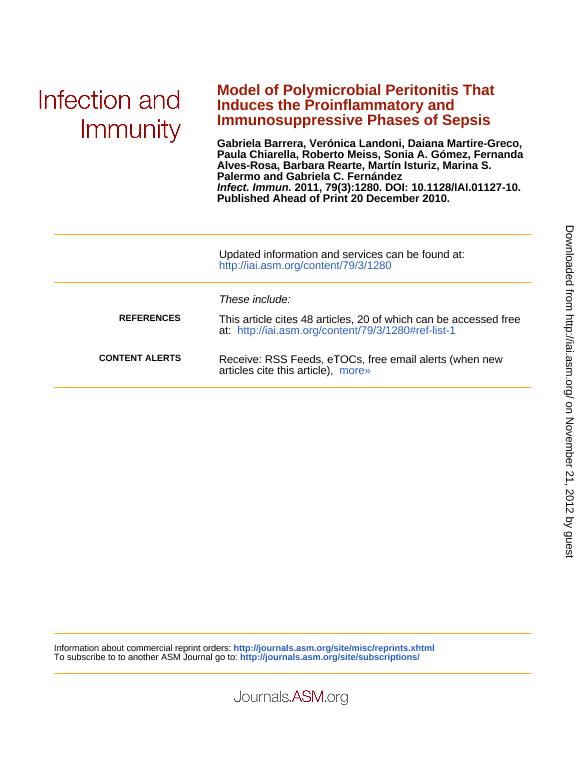Artículo
Model of Polymicrobial Peritonitis That Induces the Proinflammatory and Immunosuppressive Phases of Sepsis
Barrera, Gabriela; Landoni, Verónica Inés ; Martire Greco, Daiana
; Martire Greco, Daiana ; Chiarella, Paula
; Chiarella, Paula ; Meiss, Roberto; Gómez, Sonia Alejandra
; Meiss, Roberto; Gómez, Sonia Alejandra ; Alves Rosa, Fernanda; Rearte, María Bárbara
; Alves Rosa, Fernanda; Rearte, María Bárbara ; Isturiz, Martín Amadeo
; Isturiz, Martín Amadeo ; Palermo, Marina Sandra
; Palermo, Marina Sandra ; Fernández, Gabriela Cristina
; Fernández, Gabriela Cristina
 ; Martire Greco, Daiana
; Martire Greco, Daiana ; Chiarella, Paula
; Chiarella, Paula ; Meiss, Roberto; Gómez, Sonia Alejandra
; Meiss, Roberto; Gómez, Sonia Alejandra ; Alves Rosa, Fernanda; Rearte, María Bárbara
; Alves Rosa, Fernanda; Rearte, María Bárbara ; Isturiz, Martín Amadeo
; Isturiz, Martín Amadeo ; Palermo, Marina Sandra
; Palermo, Marina Sandra ; Fernández, Gabriela Cristina
; Fernández, Gabriela Cristina
Fecha de publicación:
03/2011
Editorial:
American Society for Microbiology
Revista:
Infection and Immunity
ISSN:
0019-9567
Idioma:
Inglés
Tipo de recurso:
Artículo publicado
Clasificación temática:
Resumen
Severe sepsis is associated with early release of inflammatory mediators that contribute to the morbidity and mortality observed during the first stages of this syndrome. Although sepsis is a deadly, acute disease, high mortality rates have been observed in patients displaying evidence of sepsis-induced immune deactivation. Although the contribution of experimental models to the knowledge of pathophysiological and therapeutic aspects of human sepsis is undeniable, most of the current studies using animal models have focused on the acute, proinflammatory phase. We developed a murine model that reproduces the early acute phases but also the long-term consequences of human sepsis. We induced polymicrobial acute peritonitis (AP) by establishing a surgical connection between the cecum and the peritoneum, allowing the exit of intestinal bacteria. Using this model, we observed an acute phase with high mortality, leukopenia, increased interleukin-6 levels, bacteremia, and neutrophil activation. A peak of leukocytosis on day 9 or 10 revealed the persistence of the infection within the lung and liver, with inflammatory hepatic damage being shown by histological examination. Long-term (20 days) derangements in both innate and adaptive immune responses were found, as demonstrated by impaired systemic tumor necrosis factor alpha production in response to an inflammatory stimulus; a decreased primary humoral immune response and T cell proliferation, associated with an increased number of myeloid suppressor cells (Gr-1+ CD11b+) in the spleen; and a low clearance capacity. This model provides a good approach to attempt novel therapeutic interventions directed to augmenting host immunity during late sepsis
Palabras clave:
SEPSIS MODEL
,
IMMUNOSUPPRESSION
Archivos asociados
Licencia
Identificadores
Colecciones
Articulos(IMEX)
Articulos de INST.DE MEDICINA EXPERIMENTAL
Articulos de INST.DE MEDICINA EXPERIMENTAL
Articulos(SEDE CENTRAL)
Articulos de SEDE CENTRAL
Articulos de SEDE CENTRAL
Citación
Barrera, Gabriela; Landoni, Verónica Inés; Martire Greco, Daiana; Chiarella, Paula; Meiss, Roberto; et al.; Model of Polymicrobial Peritonitis That Induces the Proinflammatory and Immunosuppressive Phases of Sepsis; American Society for Microbiology; Infection and Immunity; 79; 3; 3-2011; 1280-1288
Compartir
Altmétricas



